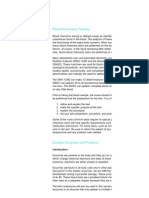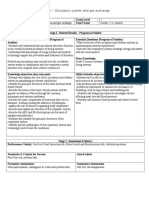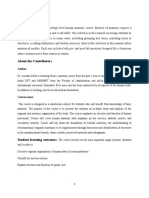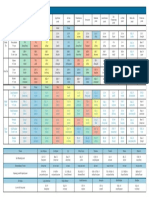0 ratings0% found this document useful (0 votes)
100 viewsAnatomy & Physiology II Exam #1 Practicum Review
Anatomy & Physiology II Exam #1 Practicum Review
Uploaded by
LucyNgoThis document provides a review guide for Anatomy & Physiology II Exam #1 Practicum covering several exercises on the endocrine system, blood, the heart, and electrocardiograms. It lists the endocrine glands and hormones to identify, the components and functions of blood, structures of the heart, the cardiac conduction system, heart sounds and blood pressure measurements. Students are advised to study the terms in bold and review class materials like powerpoints and textbook in addition to this guide for the practicum exam.
Copyright:
© All Rights Reserved
Available Formats
Download as DOC, PDF, TXT or read online from Scribd
Anatomy & Physiology II Exam #1 Practicum Review
Anatomy & Physiology II Exam #1 Practicum Review
Uploaded by
LucyNgo0 ratings0% found this document useful (0 votes)
100 views1 pageThis document provides a review guide for Anatomy & Physiology II Exam #1 Practicum covering several exercises on the endocrine system, blood, the heart, and electrocardiograms. It lists the endocrine glands and hormones to identify, the components and functions of blood, structures of the heart, the cardiac conduction system, heart sounds and blood pressure measurements. Students are advised to study the terms in bold and review class materials like powerpoints and textbook in addition to this guide for the practicum exam.
Copyright
© © All Rights Reserved
Available Formats
DOC, PDF, TXT or read online from Scribd
Share this document
Did you find this document useful?
Is this content inappropriate?
This document provides a review guide for Anatomy & Physiology II Exam #1 Practicum covering several exercises on the endocrine system, blood, the heart, and electrocardiograms. It lists the endocrine glands and hormones to identify, the components and functions of blood, structures of the heart, the cardiac conduction system, heart sounds and blood pressure measurements. Students are advised to study the terms in bold and review class materials like powerpoints and textbook in addition to this guide for the practicum exam.
Copyright:
© All Rights Reserved
Available Formats
Download as DOC, PDF, TXT or read online from Scribd
Download as doc, pdf, or txt
0 ratings0% found this document useful (0 votes)
100 views1 pageAnatomy & Physiology II Exam #1 Practicum Review
Anatomy & Physiology II Exam #1 Practicum Review
Uploaded by
LucyNgoThis document provides a review guide for Anatomy & Physiology II Exam #1 Practicum covering several exercises on the endocrine system, blood, the heart, and electrocardiograms. It lists the endocrine glands and hormones to identify, the components and functions of blood, structures of the heart, the cardiac conduction system, heart sounds and blood pressure measurements. Students are advised to study the terms in bold and review class materials like powerpoints and textbook in addition to this guide for the practicum exam.
Copyright:
© All Rights Reserved
Available Formats
Download as DOC, PDF, TXT or read online from Scribd
Download as doc, pdf, or txt
You are on page 1of 1
Anatomy & Physiology II Exam #1 Practicum
Practicum will cover 27, 29, 30, 31,
Exercise 27
Be able to identify all the endocrine glands from slide
Be able to identify all the glands from slide and give the hormones that are released
Be able to identify all the glands from slide and give the function of the hormones that are released
Glands: Pituitary gland
Thyroid gland
Parathyroid gland
Pancreas
Adrenal gland
Testis
Ovary
Know the functions of the endocrine system
Know what a hormone is
Know the zones of the adrenal gland and the class of hormones present in the zone
Exercise 29A
Know the function of blood
Know the composition of blood
Know the formed elements (RBC and WBC) and their characteristics be able to identify on model
Know the 5 types of WBC and the most abundant to least abundant
Know the hematologic tests
Know what hematocrit is and know the normal values for males and females
Know the types of blood and know the antigen and antibody present for that type
Know how to determine a blood type from unknown and be able to identify
Exercise 30
Know the function of the heart (cardiovascular system)
Know the difference between pericardium, myocardium, endocardium
Know the 4 chambers of the heart
Know the 4 valves of the heart
Know the functions of arteries and veins of the heart
Be able to identify the anatomical structures of the heart from sheep specimen and models
Exercises 31
Know the components of the intrinsic conduction system, locations of components, and the pathway of
the electrical activity of the heart.
Know diastolic, systolic, relaxation, contraction, repolarization, depolarization terms
Know what an electrocardiogram is
Know the components of an electrocardiogram and what they represent (P, QRS, T)
Know what blood pressure is, know normal, ranges, prehypertension, hypertension Exam #2
Know what pulse is, know normal, range, bradycardia, tachycardia
Know the heart sounds, and what sound they make and which valve is closing
Know Models Specimens and Slides
Thank You Good Luck Studying Any Questions Email
Also please note this is just a guide to help study for practicum, this is not a reflection of the actual
exam and please note something may not be mentioned on this review that will be on practicum but
however it was covered in class (lecture & lab) So please review bold terms in your etext and review
the powerpoints, and visit the SLC
You might also like
- Essential Examination, third edition: Step-by-step guides to clinical examination scenarios with practical tips and key facts for OSCEsFrom EverandEssential Examination, third edition: Step-by-step guides to clinical examination scenarios with practical tips and key facts for OSCEsRating: 3 out of 5 stars3/5 (5)
- Final FRCA Viva Questions From June 2011 Exam Some General Feedback For The Day For Any Future CandidatesDocument56 pagesFinal FRCA Viva Questions From June 2011 Exam Some General Feedback For The Day For Any Future Candidatesjahangirealam89% (9)
- Primary FRCA OSCE QuestionsDocument10 pagesPrimary FRCA OSCE QuestionsDsd100% (2)
- Harman Autopsy Report, Trails CarolinaDocument8 pagesHarman Autopsy Report, Trails CarolinaLeigh EganNo ratings yet
- Medical Terminology: Learn to Pronounce, Understand and Memorize Over 2000 Medical TermsFrom EverandMedical Terminology: Learn to Pronounce, Understand and Memorize Over 2000 Medical TermsRating: 5 out of 5 stars5/5 (1)
- Stocker and Dehner's Pediatric PathologyDocument2,196 pagesStocker and Dehner's Pediatric PathologyJose SirittNo ratings yet
- Pass ProgramDocument528 pagesPass ProgramEvelyn Lee Russell67% (3)
- A Guide To MRCS Part BDocument7 pagesA Guide To MRCS Part BWilson Ong Ying FaNo ratings yet
- Cardio Exam Test BankDocument17 pagesCardio Exam Test BankPINKY CUARESMA0% (1)
- A CARE STUDY HypertensionDocument48 pagesA CARE STUDY Hypertensionjeff_jj2000209790% (10)
- Science Discovers The Physiological Value of Continence 2Document20 pagesScience Discovers The Physiological Value of Continence 2shaswata_panjaNo ratings yet
- Cardio 1stSemSY2014-15 Course SyllabusDocument6 pagesCardio 1stSemSY2014-15 Course SyllabusBeryl Ben MergalNo ratings yet
- BIO 211 Anatomy & Physiology II Study Guide For Cumulative Final ExamDocument3 pagesBIO 211 Anatomy & Physiology II Study Guide For Cumulative Final ExamJasonNo ratings yet
- Ismail Raslan & Musab AlmoshiqehDocument40 pagesIsmail Raslan & Musab AlmoshiqehSaya Menang100% (2)
- EXS 208 - Anatomy and Physiology II Cardiovascular System Study Guide General AbilitiesDocument3 pagesEXS 208 - Anatomy and Physiology II Cardiovascular System Study Guide General AbilitiesAnonymous CHVzVzf3uRNo ratings yet
- 2nd Smesster Physiology Course SpecificationDocument6 pages2nd Smesster Physiology Course SpecificationharisNo ratings yet
- Cardiovascular WorksheetDocument4 pagesCardiovascular WorksheetAnonymous V7A9OKNo ratings yet
- Chapter 1 CardiologyDocument48 pagesChapter 1 CardiologyAnh100% (2)
- Clinicalmedicine Notes OsceDocument18 pagesClinicalmedicine Notes OsceSindu Sai0% (1)
- Welcome To The Clinical LaboratoryDocument36 pagesWelcome To The Clinical LaboratoryAndi NamirahNo ratings yet
- DR Quiz 2 Study GuideDocument2 pagesDR Quiz 2 Study GuideKalesha JonesNo ratings yet
- Assign NewDocument9 pagesAssign Newsyedamasoomazahra9No ratings yet
- BG2119 Exam Handout For 2nd HalfDocument3 pagesBG2119 Exam Handout For 2nd Halfjason.liauyjNo ratings yet
- Ospe Charts 121814Document12 pagesOspe Charts 121814elanthendralkrish77No ratings yet
- Histo ExamDocument4 pagesHisto Examsayeda.raza24No ratings yet
- Listening Sample Test 9 Question PaperDocument4 pagesListening Sample Test 9 Question PaperDaljeet AhujaNo ratings yet
- TMM Pumhsw 1ST Year SyllabusDocument9 pagesTMM Pumhsw 1ST Year Syllabusmisbahsep24No ratings yet
- Cardiovascular Study GuideDocument1 pageCardiovascular Study Guideapi-306342919No ratings yet
- Circulatory System Review BeforeDocument1 pageCirculatory System Review BeforejfurajterNo ratings yet
- Get Test Bank For Interpreting ECGs: A Practical Approach, 3rd Edition Bruce Shade Free All ChaptersDocument63 pagesGet Test Bank For Interpreting ECGs: A Practical Approach, 3rd Edition Bruce Shade Free All ChaptersmackicjubiiNo ratings yet
- Lecture May 182024Document17 pagesLecture May 182024Jene GalacNo ratings yet
- HA Lab Week 17 - Diagnostic Tests 1Document9 pagesHA Lab Week 17 - Diagnostic Tests 1Desiree LadabanNo ratings yet
- The Exam Will Be 25 Multiple Choice Questions Worth 2 Points EachDocument1 pageThe Exam Will Be 25 Multiple Choice Questions Worth 2 Points EachviaereaNo ratings yet
- OBSERVED OSPE SHIFT 1 (Day 3Document4 pagesOBSERVED OSPE SHIFT 1 (Day 3mukarramqadirNo ratings yet
- Human Body Systems Test Review Body System Function Major Organs/Structures & Their Functions Specialized Cells (If Any)Document8 pagesHuman Body Systems Test Review Body System Function Major Organs/Structures & Their Functions Specialized Cells (If Any)Christine Megan YoungNo ratings yet
- Study Guide For Biology MidtermDocument5 pagesStudy Guide For Biology Midtermkal51No ratings yet
- Study Guide For Cell Theory TestDocument2 pagesStudy Guide For Cell Theory Testchaine1No ratings yet
- Laboratory Tests InterpretationDocument2 pagesLaboratory Tests InterpretationMaria ClaritaNo ratings yet
- Heart and Neck VesselsDocument44 pagesHeart and Neck VesselsRaymonddodoNo ratings yet
- Scenario - CA Assessment I - PresentationDocument6 pagesScenario - CA Assessment I - PresentationThein Mui KyunNo ratings yet
- Biology 20 Unit Plan Circulation and Gas ExchangeDocument3 pagesBiology 20 Unit Plan Circulation and Gas Exchangeapi-332074447No ratings yet
- UT Dallas Syllabus For nsc4366.001.11f Taught by Van Miller (vxm077000)Document5 pagesUT Dallas Syllabus For nsc4366.001.11f Taught by Van Miller (vxm077000)UT Dallas Provost's Technology GroupNo ratings yet
- General Discussion ScheduleDocument28 pagesGeneral Discussion ScheduleJOPEARL MAE DELA TORRENo ratings yet
- Documenting: Single-System ExamsDocument3 pagesDocumenting: Single-System ExamsJames Clerk MaxwellNo ratings yet
- EKG Cardiac Rhythm Analysis PDFDocument80 pagesEKG Cardiac Rhythm Analysis PDFIqbal Juher100% (1)
- Sem 1 SyllabusDocument9 pagesSem 1 SyllabusAdnan husen Fruit walaNo ratings yet
- Biomedical Set B AnsDocument20 pagesBiomedical Set B AnskarthikbalajimanoharanNo ratings yet
- Study Notes SurgeryDocument56 pagesStudy Notes SurgeryMedShare83% (12)
- Chest Trauma Case Discussion OutlineDocument45 pagesChest Trauma Case Discussion OutlineKenisha HutsonNo ratings yet
- Cardiovascular System Structure and Function HSCDocument26 pagesCardiovascular System Structure and Function HSCmohiuddin.ahmadNo ratings yet
- Anatomy and Physiology Final ReviewDocument4 pagesAnatomy and Physiology Final ReviewPaige PattersonNo ratings yet
- Basic_Anatomy_Chapter_wise_possible_questionsDocument4 pagesBasic_Anatomy_Chapter_wise_possible_questionsshefath532No ratings yet
- Unit 5 Cardiovascular System Work BookDocument50 pagesUnit 5 Cardiovascular System Work Bookdaisydcd523No ratings yet
- Topic 8 Endocrine and Nervous System ProteinsDocument35 pagesTopic 8 Endocrine and Nervous System Proteinstmg.35566No ratings yet
- Anatomy & Physiology: Exam Study GuideDocument4 pagesAnatomy & Physiology: Exam Study GuideJessan Ybañez JoreNo ratings yet
- Important Short Questions & Answers: Human Anatomy & Physiology HAP 20114Document12 pagesImportant Short Questions & Answers: Human Anatomy & Physiology HAP 20114Kunal DangatNo ratings yet
- SGH How To Approach SBAsDocument49 pagesSGH How To Approach SBAsArnav RaiNo ratings yet
- Diagnosing Heart DiseaseDocument3 pagesDiagnosing Heart DiseaseJaz SantosNo ratings yet
- 2017-18 Anatphys SyllabusDocument7 pages2017-18 Anatphys Syllabusapi-266971550No ratings yet
- PsychiatryFrom EverandPsychiatryAsher B. SimonNo ratings yet
- Anatomy, Physiology, and Pathology, Third Edition: A Practical, Illustrated Guide to the Human Body for Students and Practitioners--Clear and accessible, with study tips and full-color visual aidsFrom EverandAnatomy, Physiology, and Pathology, Third Edition: A Practical, Illustrated Guide to the Human Body for Students and Practitioners--Clear and accessible, with study tips and full-color visual aidsNo ratings yet
- ECG & EKG Interpretation: How to interpret ECG & EKG, including rhythms, arrhythmias, and more!From EverandECG & EKG Interpretation: How to interpret ECG & EKG, including rhythms, arrhythmias, and more!No ratings yet
- Anesthetic Considerations For Abdominal TraumaDocument14 pagesAnesthetic Considerations For Abdominal TraumaTrinh TrầnNo ratings yet
- Lecture - Chapter 37 - Endocrine SystemDocument21 pagesLecture - Chapter 37 - Endocrine SystemAnonymous SrGzihNo ratings yet
- Cardiorespiratory System: Structure and FunctionsDocument19 pagesCardiorespiratory System: Structure and FunctionsKasam ANo ratings yet
- Exp No. 6 (A) SpermatogenesisDocument2 pagesExp No. 6 (A) SpermatogenesisShadab AhmadNo ratings yet
- Lab 6 - Overview of The Skeletal SystemDocument6 pagesLab 6 - Overview of The Skeletal Systemsidro123No ratings yet
- Chemical Coordination and Integration UnderlineDocument16 pagesChemical Coordination and Integration Underlinelove.mansijhaNo ratings yet
- Soal Ujian Neuroscience 2012 HJDDocument26 pagesSoal Ujian Neuroscience 2012 HJDCox AbeeNo ratings yet
- Cadeias Linfonodais Do AbdomeDocument9 pagesCadeias Linfonodais Do Abdomececiliatigre10No ratings yet
- Skeletal System - Lesson 19Document25 pagesSkeletal System - Lesson 19Suset Binongo LosanoyNo ratings yet
- Practical 2Document15 pagesPractical 2Jaan JeeNo ratings yet
- 5 Class XII Zoology CHSE WorkbookDocument48 pages5 Class XII Zoology CHSE Workbookrockydalabehera94No ratings yet
- Jett Plasma Lift 234Document39 pagesJett Plasma Lift 234SuzanaFonsecaNo ratings yet
- Health Fitness - WeeblyDocument31 pagesHealth Fitness - Weeblyapi-236015729No ratings yet
- Development of Embryo ChickDocument14 pagesDevelopment of Embryo ChickSafira Dwi OktavianiNo ratings yet
- ABO Blood TypesDocument22 pagesABO Blood Typesabhi143srsNo ratings yet
- Digestive SystemDocument2 pagesDigestive SystemAvinash kumar DusejaNo ratings yet
- SinulDocument86 pagesSinulCucos NataliaNo ratings yet
- Points From Accupuncture AtlasDocument1 pagePoints From Accupuncture AtlasdishkuNo ratings yet
- Gen Bio Adm q1w1Document9 pagesGen Bio Adm q1w1Jizelle CasiaNo ratings yet
- Pancreatic PseudocystDocument16 pagesPancreatic PseudocystSpandan KadamNo ratings yet
- Gen Bio 2 LAW Q4 Week 3 4 (AutoRecovered)Document12 pagesGen Bio 2 LAW Q4 Week 3 4 (AutoRecovered)Samantha DomileNo ratings yet
- Full Rosacea Diagnosis and Management 1st Edition Frank Powell PDF All ChaptersDocument69 pagesFull Rosacea Diagnosis and Management 1st Edition Frank Powell PDF All Chapterssaafnayci100% (3)
- 2) QuestionsDocument95 pages2) Questionsgita safiraNo ratings yet
- Tutorial 4 S 202301Document4 pagesTutorial 4 S 202301subhadraNo ratings yet
- Chloroplasts: "The Kitchen of The Cell"Document25 pagesChloroplasts: "The Kitchen of The Cell"MarianneNo ratings yet
- Basf Presentation Radiant SkinDocument39 pagesBasf Presentation Radiant SkinJames WuNo ratings yet

























































































